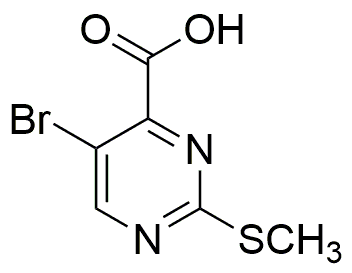5-Bromo-2-(methylthio)pyrimidine-4-carboxylic acid is widely utilized in research focused on:
- Pharmaceutical Development: This compound serves as a key intermediate in the synthesis of various pharmaceuticals, particularly in the development of antiviral and anticancer agents.
- Agricultural Chemistry: It is used in the formulation of agrochemicals, helping to create effective herbicides and fungicides that enhance crop protection and yield.
- Biochemical Research: Researchers employ this compound in studies related to enzyme inhibition and metabolic pathways, contributing to a better understanding of biological processes.
- Material Science: It finds applications in the development of novel materials, including polymers and coatings, that require specific chemical properties for enhanced performance.
- Analytical Chemistry: This chemical is utilized as a standard in analytical methods, aiding in the accurate detection and quantification of similar compounds in various samples.
Información general
Propiedades
Seguridad y normativas
Aplicaciones
5-Bromo-2-(methylthio)pyrimidine-4-carboxylic acid is widely utilized in research focused on:
- Pharmaceutical Development: This compound serves as a key intermediate in the synthesis of various pharmaceuticals, particularly in the development of antiviral and anticancer agents.
- Agricultural Chemistry: It is used in the formulation of agrochemicals, helping to create effective herbicides and fungicides that enhance crop protection and yield.
- Biochemical Research: Researchers employ this compound in studies related to enzyme inhibition and metabolic pathways, contributing to a better understanding of biological processes.
- Material Science: It finds applications in the development of novel materials, including polymers and coatings, that require specific chemical properties for enhanced performance.
- Analytical Chemistry: This chemical is utilized as a standard in analytical methods, aiding in the accurate detection and quantification of similar compounds in various samples.
Documentos
Hojas de datos de seguridad (HDS)
La SDS proporciona información de seguridad completa sobre la manipulación, el almacenamiento y la eliminación del producto.
Especificación del producto (PS)
La PS proporciona un desglose completo de las propiedades del producto, incluida la composición química, el estado físico, la pureza y los requisitos de almacenamiento. También detalla los rangos de calidad aceptables y las aplicaciones previstas del producto.
Certificados de análisis (COA)
Busque certificados de análisis (COA) ingresando el número de lote del producto. Los números de lote y de partida se pueden encontrar en la etiqueta de un producto después de las palabras "Lote" o "Lote".
Número de catálogo
Número de lote/lote
Certificados de origen (COO)
Este certificado de origen confirma el país en el que se fabricó el producto y también detalla los materiales y componentes utilizados en él y si se deriva de fuentes naturales, sintéticas u otras fuentes específicas. Este certificado puede ser necesario para cumplir con las normativas aduaneras, comerciales y regulatorias.
Número de catálogo
Número de lote/lote
Hojas de datos de seguridad (HDS)
La SDS proporciona información de seguridad completa sobre la manipulación, el almacenamiento y la eliminación del producto.
DownloadEspecificación del producto (PS)
La PS proporciona un desglose completo de las propiedades del producto, incluida la composición química, el estado físico, la pureza y los requisitos de almacenamiento. También detalla los rangos de calidad aceptables y las aplicaciones previstas del producto.
DownloadCertificados de análisis (COA)
Busque certificados de análisis (COA) ingresando el número de lote del producto. Los números de lote y de partida se pueden encontrar en la etiqueta de un producto después de las palabras "Lote" o "Lote".
Número de catálogo
Número de lote/lote
Certificados de origen (COO)
Este certificado de origen confirma el país en el que se fabricó el producto y también detalla los materiales y componentes utilizados en él y si se deriva de fuentes naturales, sintéticas u otras fuentes específicas. Este certificado puede ser necesario para cumplir con las normativas aduaneras, comerciales y regulatorias.


